
18-19 April 2024




18-19 April 2024


Thursday 18 April,2pm, The Queen's Hall, Edinburgh
Friday 19 April, 2pm, City Halls, Glasgow
MAXWELL DAVIES Concert Overture ‘Ebb of Winter’ *
NIELSEN Flute Concerto
Interval of 20 minutes
SIBELIUS The Swan of Tuonela
NIELSEN (orch. Swensen) Four Movements for Orchestra
Joseph Swensen Conductor
André Cebrián Flute
Katherine Bryer Cor Anglais
*The performance of Peter Maxwell Davies’ Ebb of Winter is supported by Resonate, a PRS Foundation initiative in partnership with Association of British Orchestras, BBC Radio 3 and Boltini Trust



4 Royal Terrace, Edinburgh EH7 5AB +44 (0)131 557 6800 | info@sco.org.uk | sco.org.uk
The Scottish Chamber Orchestra is a charity registered in Scotland No. SC015039. Company registration No. SC075079.
Our Principal Conductor’s Circle are a special part of our musical family. Their commitment and generosity benefit us all – musicians, audiences and creative learning participants alike.
Annual Fund
James and Patricia Cook
Visiting Artists Fund
Colin and Sue Buchan
Harry and Carol Nimmo
Anne and Matthew Richards
International Touring Fund
Gavin and Kate Gemmell
Creative Learning Fund
Sabine and Brian Thomson
CHAIR SPONSORS
Conductor Emeritus Joseph Swensen
Donald and Louise MacDonald
Chorus Director Gregory Batsleer
Anne McFarlane
Principal Second Violin
Marcus Barcham Stevens
Jo and Alison Elliot
Second Violin Rachel Smith
J Douglas Home
Principal Viola Max Mandel
Ken Barker and Martha Vail Barker
Viola Brian Schiele
Christine Lessels
Viola Steve King
Sir Ewan and Lady Brown
Principal Cello Philip Higham
The Thomas Family
American Development Fund
Erik Lars Hansen and Vanessa C L Chang
Productions Fund
Bill and Celia Carman
Anny and Bobby White
Anne, Tom and Natalie Usher
Scottish Touring Fund
Eriadne and George Mackintosh
Claire and Anthony Tait
Cello Donald Gillan
Professor Sue Lightman
Cello Eric de Wit
Jasmine Macquaker Charitable Fund
Principal Double Bass Nikita Naumov
Caroline Hahn and Richard Neville-Towle
Principal Flute André Cebrián
Claire and Mark Urquhart
Principal Oboe Robin Williams
In memory of Hedley G Wright
Principal Clarinet Maximiliano Martín
Stuart and Alison Paul
Principal Bassoon Cerys Ambrose-Evans
Claire and Anthony Tait
Principal Timpani Louise Lewis Goodwin
Geoff and Mary Ball






Diamond
Malcolm and Avril Gourlay
John and Jane Griffiths
James and Felicity Ivory
Robin and Catherine Parbrook
Clair and Vincent Ryan
William Samuel
Tom and Natalie Usher
Platinum
David Caldwell in memory of Ann
Judith and David Halkerston
Audrey Hopkins
David and Elizabeth Hudson
Dr and Mrs Peter Jackson
Dr Daniel Lamont
Chris and Gill Masters
Duncan and Una McGhie
Anne-Marie McQueen
James F Muirhead
Patrick and Susan Prenter
Mr and Mrs J Reid
George Ritchie
Martin and Mairi Ritchie
Hilary E Ross
Elaine Ross
George Rubienski
Jill and Brian Sandford
Michael and Elizabeth Sudlow
Robert and Elizabeth Turcan
Alan and Sue Warner
Finlay and Lynn Williamson
Dr Peter Williamson and Ms Margaret Duffy
Ruth Woodburn
William Zachs
Gold
John and Maggie Bolton
Kate Calder
Lord Matthew Clarke
Jo and Christine Danbolt
James and Caroline Denison-Pender
Andrew and Kirsty Desson
David and Sheila Ferrier
Chris and Claire Fletcher
Dr J W E Forrester
James Friend
Adam Gaines and Joanna Baker
Margaret Green
Iain Gow
Christopher and Kathleen Haddow
Catherine Johnstone
Gordon Kirk
Robert Mackay and Philip Whitley
Mike and Karen Mair
Anne McAlister and Philip Sawyer
Roy and Svend McEwan-Brown
John and Liz Murphy
Maggie Peatfield
Charles Platt
Alison and Stephen Rawles
Andrew Robinson
Olivia Robinson
Irene Smith
Ian S Swanson
John-Paul and Joanna Temperley
James Wastle and Glenn Craig
Bill Welsh
Catherine Wilson
Neil and Philippa Woodcock
G M Wright
Bruce and Lynda Wyer
Silver
Roy Alexander
Pamela Andrews and Alan Norton
Dr Peter Armit
William Armstrong
Fiona and Neil Ballantyne
Timothy Barnes and Janet Sidaway
The Batsleer Family
Jack Bogle
Jane Borland
Alan Borthwick
Michael and Jane Boyle
Mary Brady
Elizabeth Brittin
John Brownlie
Laura Buist
Robert Burns
Sheila Colvin
Lorn and Camilla Cowie
Philip Croft and David Lipetz
Lord and Lady Cullen of Whitekirk
Adam and Lesley Cumming
Dr Wilma Dickson
Sylvia Dow
Dr and Mrs Alan Falconer
Sheila Ferguson
Malcolm Fleming
Dr William Irvine Fortescue
Dr David Grant
Andrew Hadden
J Martin Haldane
Ronnie and Ann Hanna
Ruth Hannah
Robin Harding
Roderick Hart
Norman Hazelton
Ron and Evelynne Hill
Philip Holman
Clephane Hume
Tim and Anna Ingold
David and Pamela Jenkins
Susannah Johnston and Jamie Weir
Julie and Julian Keanie
Marty Kehoe
Professor Christopher and Mrs Alison Kelnar
Dr and Mrs Ian Laing
Janey and Barrie Lambie
Graham and Elma Leisk
Geoff Lewis
Dorothy A Lunt
Vincent Macaulay
James McClure in memory of Robert Duncan
Gavin McCrone
Brian Miller
James and Helen Moir
Alistair Montgomerie
Margaret Mortimer and Ken Jobling
Andrew Murchison
Hugh and Gillian Nimmo
David and Tanya Parker
Hilary and Bruce Patrick
John Peutherer in memory of Audrey Peutherer
James S Potter
Alastair Reid
Fiona Reith
Catherine Steel
Ian Szymanski
Takashi and Mikako Taji
Douglas and Sandra Tweddle
C S Weir
We are indebted to everyone acknowledged here who gives philanthropic gifts to the SCO of £300 or greater each year, as well as those who prefer to remain anonymous.
We are also incredibly thankful to the many individuals not listed who are kind enough to support the Orchestra financially on a regular or ad hoc basis. Every single donation makes a difference.
Become a regular donor, from as little as £5 a month, by contacting Hannah Wilkinson on 0131 478 8364 or hannah.wilkinson@sco.org.uk.
“A crack musical team at the top of its game.”
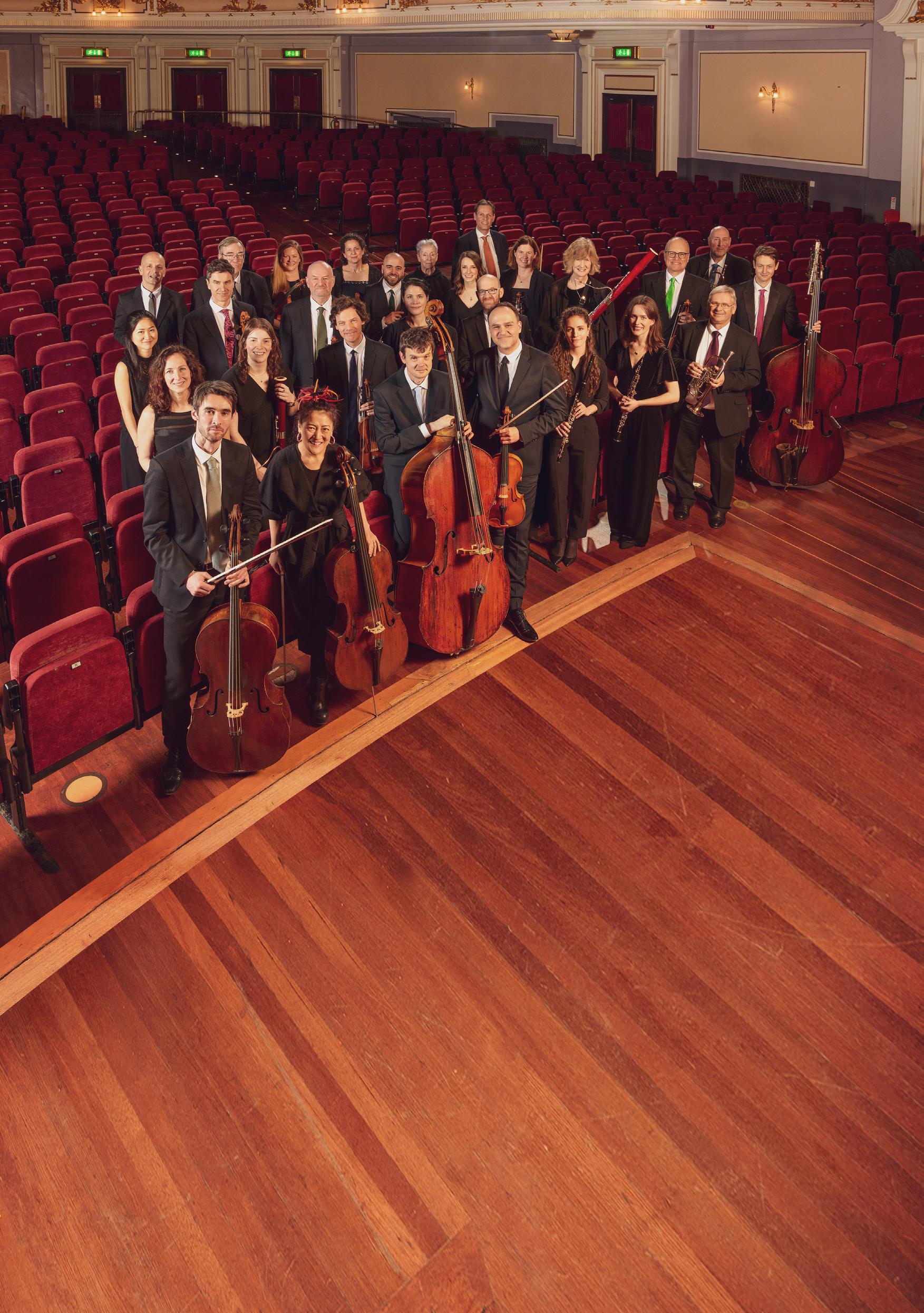
HRH The Former Duke of Rothesay
Patron
Donald MacDonald CBE Life President
Joanna Baker CBE
Chair
Gavin Reid LVO
Chief Executive
Maxim Emelyanychev Principal Conductor
Joseph Swensen Conductor Emeritus
Gregory Batsleer Chorus Director
Jay Capperauld Associate Composer
Information correct at the time of going to print
First Violin
Maia Cabeza
Afonso Fesch
Lise Aferiat
Aisling O’Dea
Siún Milne
Fiona Alexander
Amira Bedrush-McDonald
Catherine James
Second Violin
Marcus Barcham Stevens
Gordon Bragg
Michelle Dierx
Rachel Smith
Niamh Lyons
Amy Cardigan
Viola
Max Mandel
Zoë Matthews
Brian Schiele
Steve King
Cello
Philip Higham
Su-a Lee
Donald Gillan
Eric de Wit
Bass
Nikita Naumov
Jamie Kenny
Harp
Eleanor Hudson
Flute
André Cebrián
Marta Gómez
Piccolo
Marta Gómez
Oboe
Robin Williams
Katherine Bryer
Julian Scott
Cor Anglais
Katherine Bryer
Clarinet
Maximiliano Martín
William Stafford
Bass Clarinet
William Stafford
Bassoon
Luke Tucker
Alison Green
Contrabassoon
Alison Green
Horn
Ken Henderson
David Tollington
Rachel Brady
Gabi Rodriguez
Trumpet
Peter Franks
Shaun Harrold
Trombone
Nigel Cox
Jamie Tweed
Alan Adams
Timpani
Richard Cartlidge
Percussion
Iain Sandilands
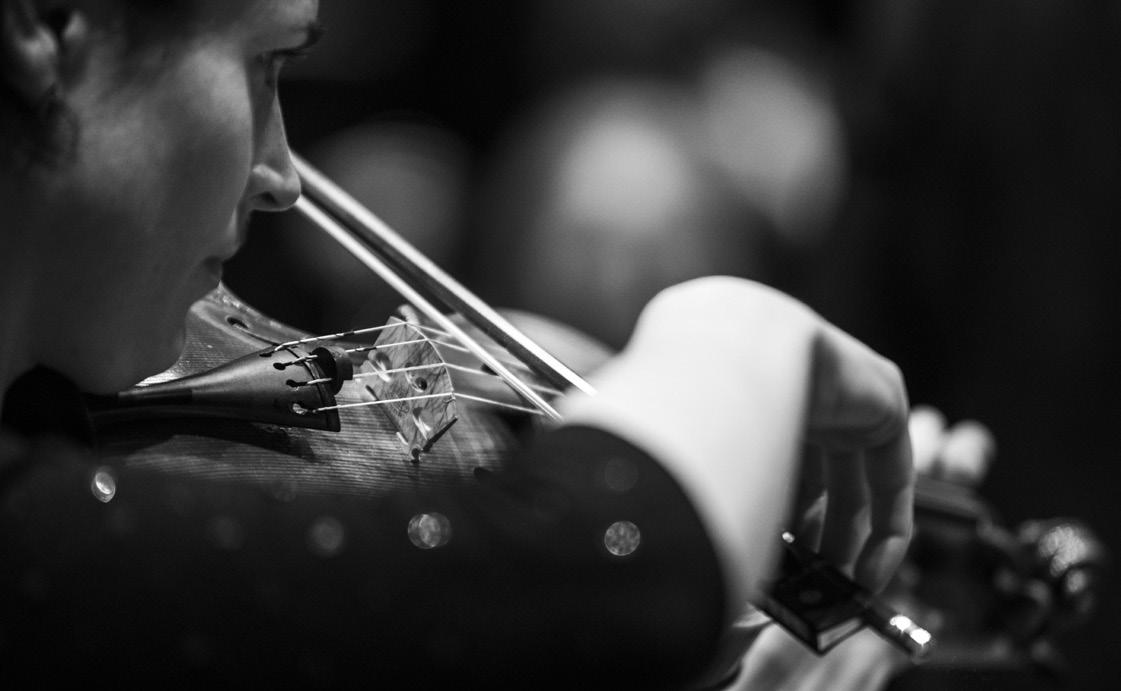
First Violin
Siún MilneMAXWELL DAVIES (1934-2016)
Concert Overture ‘Ebb of Winter’ (2013)
The performance of Peter Maxwell Davies’ Ebb of Winter is supported by Resonate, a PRS Foundation initiative in partnership with Association of British Orchestras, BBC Radio 3 and Boltini Trust.

NIELSEN (1865-1931)
Flute Concerto (1926)
Allegro moderato
Allegretto un poco - Adagio ma non troppoAllegretto - Poco adagio - Tempo di marcia
SIBELIUS (1809–1847)
The Swan of Tuonela, Op 22 No 2 (1895, rev. 1897 and 1900)
NIELSEN (1865-1931)
Four Movements for Orchestra (1888)
orch. Swensen (1988)
Allegro energico
Andante amoroso
Scherzo Allegro molto
Finale Allegro (inquieto)
Think of music from northern Europe, and images of epic landscapes, forests, lakes, fjords, and icy wildernesses might well come to mind. They’re part of the story, certainly – as you’ll hear in the hard-won anticipation of spring in our opening piece, and also courtesy of Sibelius’s avian protector of the Finnish underworld after the interval. There’s a whole other side to Nordic music in today’s concert, however, and it’s one that’s embodied in the music of the exuberant Danish musical prankster Carl Nielsen – as we’ll discover shortly.
We begin, however, not in Finland or Denmark, but far closer to home. Peter Maxwell Davies was born in Salford, and gained an infamous reputation as one of the angry young men of British avant-garde music in the 1960s, writing uncompromisingly difficult, thorny works that often set out intentionally to shock – most notoriously, perhaps, in his harrowing musical portrait of George III from 1969, Eight Songs for a Mad King . Things changed dramatically in 1971, however, when Maxwell Davies began a new life in Orkney, where he remained until his death in 2016. He quickly became deeply connected with Orcadian life and music, and closely involved in the music education of the islands’ youngsters too. And though it wouldn’t necessarily be right to say his music mellowed, it certainly took on a calmer, more thoughtful aspect, one that’s immediately evident in the piece that opens tonight’s concert, Ebb of Winter .
Maxwell Davies wrote the piece in 2013 for the Scottish Chamber Orchestra’s 40th anniversary celebrations. And Max (as just about everyone who knew him called him) had a close relationship with
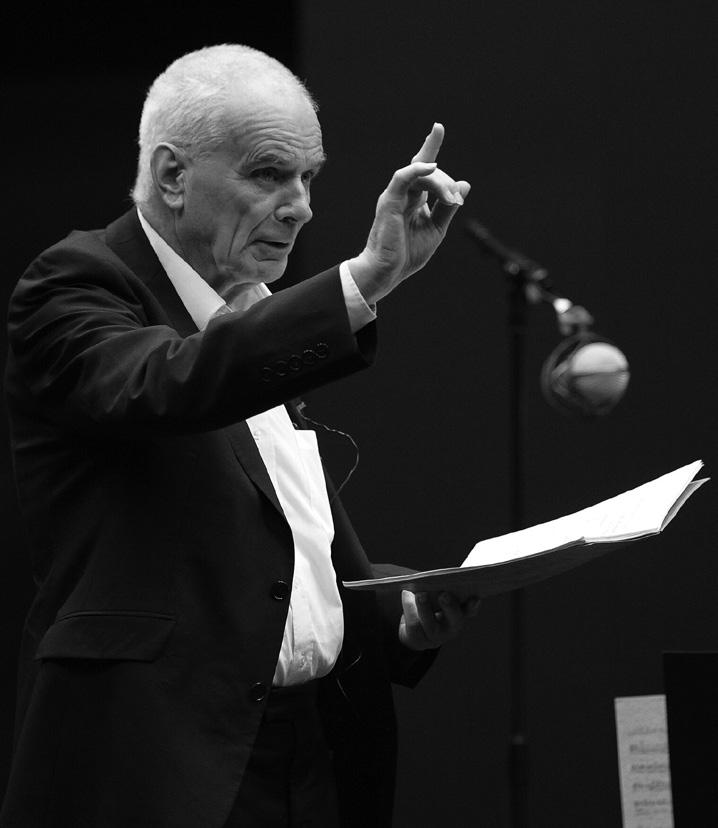 Peter Maxwell Davies
Peter Maxwell Davies
the SCO that lasted many years. He wrote many pieces for the Orchestra – the first, Into the Labyrinth , came from way back in 1983, and most ambitious was his set of ten Strathclyde Concertos , intended specifically for SCO principal players, that he composed between 1986 and 1996. He was resident composer and conductor with the Orchestra for a number of years, and indeed gained much of his early conducting experience (as he happily acknowledged) working with the SCO’s musicians.
With all that in mind, it’s perhaps not surprising that Maxwell Davies wrote Ebb of Winter almost as a miniature concerto for orchestra, with sections specifically intended to showcase individual SCO players. Nonetheless, it’s a sombre, serious-minded piece, initially inspired, Maxwell Davies explained, by walking on an Orcadian beach in the early part of the year, struggling against the wind and
Maxwell Davies wrote the piece in 2013 for the Scottish Chamber Orchestra’s 40th anniversary celebrations. And Max (as just about everyone who knew him called him) had a close relationship with the SCO that lasted many years.
sea spray, and with mist obscuring his surroundings. There were more personal influences behind the piece, too – themes that Maxwell Davies only realised once he’d completed it. It was while he was writing Ebb of Winter that he received his first diagnosis of leukaemia, initially with a prognosis of only six weeks’ survival (he’d go on to live for another three years, undergoing intensive treatment).
‘First of all, when I was writing it I was just full of the wonder of my daily walks along the beach and watching the change of the light and the coming of the spring,’ Maxwell Davies said at a pre-concert talk before Ebb of Winter ’s premiere in November 2013. ‘And then this extraordinary personal thing – which I think the music knew, but I didn't – on two levels: on the one the potentially catastrophic thing of going through all that, but then the absolute joy of coming through it.’
After a rugged opening dominated by horns and trumpets, the first theme we hear comes from the oboe, in a melodic line heavily inflected by Scottish rhythms and ornamentation that’s passed from instrument to instrument across the orchestra – even, after a raucous climax, to the timpani. There’s a restless, brooding intensity to much of the music in the piece’s long opening section, as though it’s unfolding in a series of waves, each rising to a climax only to give way to activity following close behind. Some particularly challenging, virtuosic writing for a duo of trumpets is interrupted by quiet, almost static reflections for strings. Then, following a solemn brass chorale, the music seems to falter, and even to be about to grind to a halt. But the timpani that start up a stumbling, unsteady march rhythm, injecting new determination into the music. As the percussionist moves from the low growl of timpani to the bright sparkle of the glockenspiel, the piece heads towards its shimmering conclusion – like, Maxwell Davies said, the image of a pale sun seen through sea spray. It’s a hard-won brightness that’s a far cry from glorious triumph, but there’s nonetheless a clear sense of resilience, hope and strength in the piece’s final moments – of new beginnings, even new spring life.
From dogged determination to mischievous fun: there’s an abrupt change in mood with today’s next piece. Undoubtedly Denmark’s most prominent 20th-century composer, Carl Nielsen was also a figure whose music matched profound philosophical insight (just take any of his six symphonies, for example) with an easy-going way of not taking things too seriously.
We’ll hear more from the younger Nielsen at the end of today’s concert. His Flute Concerto, however, comes from 1926, just five years before his death. He’d been inspired by hearing the Copenhagen Wind Quintet playing Mozart in 1921, and after composing a Wind Quintet of his own for them, vowed to write each individual player their own concerto. He only survived long enough to compose two of the five, however – today’s Flute Concerto, and the Clarinet Concerto he finished in 1928. It even proved a struggle to complete the Flute Concerto for its scheduled Paris premiere in October 1926. Nielsen was touring Germany and Italy in the preceding months, and came down with a serious stomach complaint that delayed work on the piece. In the end, Paris had to make do with a ‘temporary’ ending (Nielsen completed his proper conclusion for the Concerto’s Copenhagen premiere in January 1927). Nonetheless, the piece went down a treat, and the composer described the performance as one of the greatest experiences of his life. Even Ravel and Honegger, both in the audience, admired it.
Nielsen wrote his own, extremely detailed programme note for a 1929 performance of the Concerto, in which he explained his overall conception of his solo instrument: ‘The flute cannot deny its own nature, its home is in Arcadia and it prefers pastoral moods. Hence, the composer has had to follow the mild character of the instrument if he did not want to run the risk of being called a barbarian.’
If the flute is our mild-mannered protagonist, however, it’s joined by a far more mischievous, unpredictable counterpart in the bass trombone, which

seems to invade the music like a joker at key moments, throwing in unexpected complications and sometimes distracting our soloist from what they were trying to communicate. The trombone was the instrument that Nielsen himself played as a teenager in a military band in Odense, where he grew up. Coincidence? Very possibly, though it’s intriguing that Nielsen might have cast himself as a supporting player in the Concerto he was writing for a friend. In any case, the two protagonists seem to find some kind of resolution by the end of the Concerto. ‘Here in a nutshell,’ Nielsen explained in his programme note, ‘is what I demand of all art – opposing forces that meet and glow, appearing one but remaining two, embracing and caressing like rippling water over pebbles, yet never actually touching and breaking the delicate interplay.’
It’s a highly idiosyncratic piece, in which Nielsen clearly holds no truck with
It’s a highly idiosyncratic piece, in which Nielsen clearly holds no truck with established expectations of classical concertos.
established expectations of classical concertos. It’s in just two movements, and he opens the first with a blaring dissonance: dashing figurations in strings and woodwind are set against what’s apparently an entirely foreign note in the lower instruments. Even when the flute enters, it seems to be playing in quite a different rhythm from what the orchestra has just established. The flautist leads the music through many different settings and moods – quite a few of them warmly bucolic – before the bass trombone makes its entrance over thudding timpani about halfway through the movement. The flautist is evidently alarmed, but after no fewer than two solo cadenzas, leads the orchestra to a restrained but luminous conclusion.
Urgent rhythmic ideas from the strings launch the second movement (‘a little nastiness in some notes cast forth by the orchestra,’ in Nielsen’s own description).
Carl Nielsen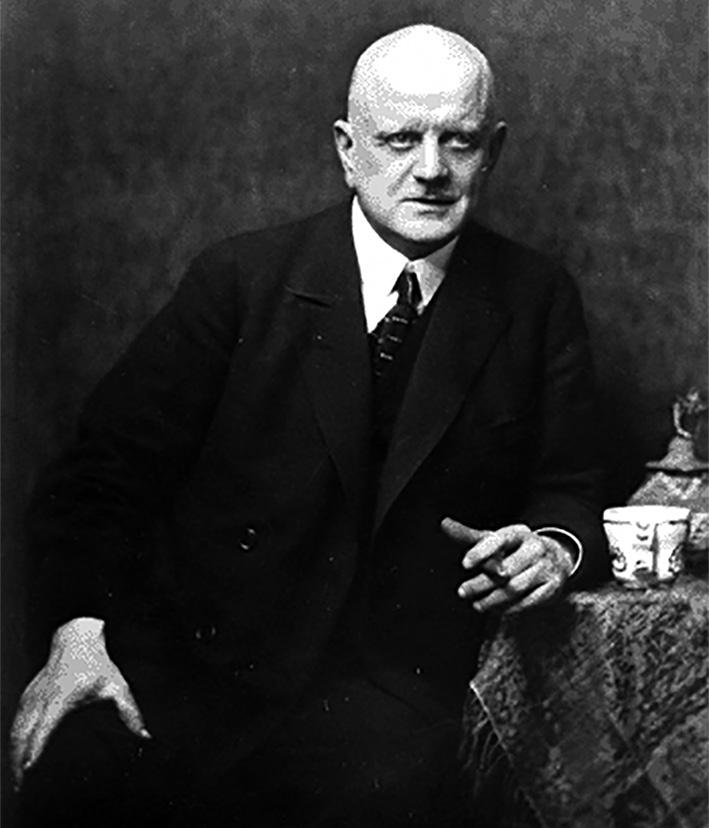
When the flute enters, however, it’s with a far gentler, more folk-like melody. Nonetheless, there’s a similarly searching, restless quality in the music to that of the opening movement. Things coalesce, however, in a whimsical little march tune, which the bass trombone quickly makes its own. The flute clearly isn’t happy, and takes the trombonist aside for a quiet word, with only the timpani keeping the peace between them. In the end, though, the flute succeeds in keeping the trombone quiet – until the raucous brass player has the last laugh (quite literally) in the Concerto’s closing moments.
From Danish mischief and merriment, we slide downwards into the Finnish underworld for today’s next piece. The Swan of Tuonela glides majestically in the wide, dark river that circles the realm of the dead in the Finnish mythological epic the Kalevala, and is also the subject of the second movement of Sibelius’s
The Swan of Tuonela, anuncannypiecethat managestobeboth opulentlymagicaland sombrelysinisteratthe sametime–qualities helped,certainly,by Sibelius’sparticulaly velvetystringwriting.
Lemminkäinen Suite, named after the epic’s doomed hero. He’s been sent to Tuonela to kill the sacred bird, but is shot himself with a poisoned arrow.
Sibelius’s otherworldly music began life as a possible overture to a Kalevala-themed opera, The Building of the Boat . When the composer abandoned the operatic project, however, he reused the music in his Lemminkäinen Suite, premiered in 1896. It’s an uncanny piece that manages to be both opulently magical and sombrely sinister at the same time –qualities helped, certainly, by Sibelius’s particulaly velvety string writing, which divides the orchestral string section into 13 separate parts for most of the piece. The cor anglais sings the strange, keening song of the swan, cushioned on the rich soundscape of dark string harmonies.
To close today’s concert, we return to Denmark, and to Carl Nielsen. He wrote
six powerful, highly individual symphonies across the course of his career. Thanks to today’s conductor Joseph Swensen, however, we’ll be hearing a seventh – well, kind of. Four Movements for Orchestra is Swensen’s orchestration of Nielsen’s First String Quartet, completed by the 23-yearold composer in 1888, and only given its premiere a decade later, in February 1898 in Copenhagen.
And though the Quartet went down well as its first performance – in a concert devoted entirely to Nielsen’s music – it ended up rarely performed during the composer’s lifetime, and has fared little better since. Bringing this youthful, vigorous, exuberant music to a wider audience was part of Swensen’s motivation for creating an orchestral version. Another reason, however, is simply the music’s power and ambition: it’s almost as if, to go back to our symphonic reference, Nielsen was forcing orchestral-style ideas into the medium of a string quartet, simply because that was an ensemble more readily available to him early in his career.
Swensen followed his own instincts in orchestrating the music, he’s said, as well as taking guidance from some of Nielsen’s early orchestral works. But aside from a few timpani strokes, nothing has been added or reworked: Swensen set himself the rule of not changing anything from Nielsen’s original quartet score, but instead reimagining its ideas with additional tone colours from woodwind, brass and percussion.
Not for nothing did Nielsen term his first movement ‘Allegro energico’: the music bursts into vivid life with a rising theme, then a quicker transitional idea (passed
from violins to flute) leading into a deeply lyrical, romantic second main melody, first heard on a horn before flowering across the full orchestra. The central development section breaks those themes down into smaller fragments, recombining them in unusual and often unexpected ways, but when the opening music returns, it’s transfigured, emboldened, and cast on an ambitious new level. That bounding energy from the opening soon flags, however, and the movement drifts to a quiet, reflective close.
There’s almost the sound of a church organ or harmonium behind the lyrical wind theme that opens Nielsen’s second movement, before a solo violin takes over with a wistful contrasting melody. The muscular scherzo of the third movement sounds as if it might be a Nordic answer to one of Brahms’s Hungarian Dances. Its stormy outer sections surround a more rustic central trio, played over a rocking drone in the cellos.
Nielsen’s finale, unusually termed Allegro (inquieto), has an appropriately agitated, unsettled quality. Its opening theme seems to push perpetually forward, with some distinctive repeated notes that set off similar patterns across the orchestra. It’s answered by a gentler, more folk-like theme for two clarinets, and the central development section combines both those ideas. When his opening material returns, however, Nielsen interrupts it with what he calls a ‘Résumé’, revisiting melodies from earlier in the piece. It’s the folk-like theme that eventually drives the piece to its sonorous, triumphant conclusion.
© David Kettle
Characterised by the strength of the bonds forged through long-lasting and loyal relationships with numerous orchestras and their audiences, Joseph Swensen's activity as a conductor extends throughout Europe and beyond, without regard to geographical or cultural borders. Praised by critics in particular for his interpretations of the great romantic repertoire such as Mahler, Bruckner and Sibelius, he is also a musical explorer who ventures into much more experimental terrain when working with smaller ensembles, and whose programmes regularly include 21st century composers alongside works from the classical period.
The result of an exceptional musical encounter and a relationship that has developed over the last decade, Joseph Swensen will take up his new position as Music Director of the Orchestre National de Bordeaux Aquitaine at the start of the 2024-25 season. He is also Principal Guest Conductor of the Orquesta Ciudad de Granada in Spain, and from the 2023-24 season, at the conclusion of his six-year tenure as Artistic Director of the NFM Leopoldinum Orchestra in Wrocław, he will continue his collaboration there as Principal Guest Conductor. He also holds the title of Conductor Emeritus of the Scottish Chamber Orchestra, of which he was Principal Conductor from 1996 to 2005.
A multifaceted musician, Joseph Swensen is an active composer and orchestrator. His orchestration of Prokofiev’s Five Songs Without Words (1920) is published by Boosey and Hawkes and Signum recorded Sinfonia in B (2007), an orchestration of the rarely performed 1854 version of Brahms’ Trio Op 8. His work also includes orchestrations of Nielsen Quartet in G minor, Four Movements for Orchestra (1888) as well as arrangements for string orchestras of Beethoven String Quartet op 131 and Debussy String Quartet, which he recorded with the NFM Leopoldinum. His most notable compositions include Shizue (2001) for solo shakuhachi and orchestra, and the Sinfonia-Concertante for Horn and Orchestra (The Fire and the Rose) (2008) as well as Sinfonietta (2017) for strings and synthesizer.
A sought-after pedagogue, Joseph Swensen teaches conducting, violin and chamber music at the Royal Conservatoire of Scotland. An American of Norwegian and Japanese descent, Joseph Swensen was born in Hoboken, New Jersey and grew up in Harlem, New York City.
For full biography please visit sco.org.uk
Joseph's Chair is kindly supported by Donald and Louise MacDonald

Spanish flautist André Cebrián is in demand as an orchestral and chamber musician throughout Scotland and abroad. He was appointed Principal Flute of the Scottish Chamber Orchestra in 2020 and appears regularly as Guest Principal Flute with orchestras around the world (Sinfónica de Castilla-León, Liceu Opera, Filármonica de Gran Canaria, Sinfónica de Barcelona, RSNO, BBC Scottish, Philharmonia Zürich, Malaysian Philharmonic and Spira Mirabilis).
As a chamber musician, André has played in hundreds of chamber music festivals around Europe, performing with the Azahar Ensemble, the Natalia Ensemble or with one of his duo projects with guitarist Pedro Mateo González, pianist Irene Alfageme, or harpist Bleuenn Le Friec.
He also enjoys a busy solo career and has appeared as soloist with orchestras including Sinfónica de Galicia, Real Filharmonía de Galicia, Sinfónica de Castilla y León, Orquesta de la Comunidad de Madrid, Dresden Staatskapelle, Scottish Chamber, Georgian Sinfonietta and Filharmonia Zabrzańska.
A dedicated teacher, André loves to share his passion for music with his students at The Royal Conservatoire of Scotland, the Barenboim-Said Academy and the youth orchestras that he coaches each season.
André studied in his hometown Santiago de Compostela with Luis Soto and Laurent Blaiteau. He then went on to study in Paris, Salamanca, Madrid, Detmold and Geneva with teachers Pablo Sagredo, János Bálint and Jacques Zoon.
André's Chair is kindly supported by Claire and Mark Urquhart

Oboist Katherine Bryer enjoys a varied career working as an orchestral, solo and chamber musician with a variety of ensembles throughout the UK. After three years in Edinburgh studying with Joe Houghton at St Mary’s Music School, Katherine moved to London to pursue both a Bachelors and Masters at the Royal Academy of Music, studying oboe with Chris Cowie, Ian Hardwick and Celia Nicklin, and cor anglais with Sue Böhling and Jill Crowther.
During her time in London Katherine performed with the London Philharmonic, BBC Symphony and Philharmonia Orchestras. Katherine was appointed as Sub-Principal Oboe with the SCO in August 2022.
Katherine’s chamber pursuits have also led to performances with groups including Hebrides Ensemble, 12 Ensemble, and specialist contemporary music group, Explore Ensemble, in festivals taking her from Orkney to the Netherlands.
For full biography please visit sco.org.uk
RAVEL PIANO CONCERTO WITH STEVEN OSBORNE
24-26 Apr, 7.30pm
Perth | Edinburgh | Glasgow
ASCENDING WITH ANDREW MANZE
2-3 May, 7.30pm
Edinburgh | Glasgow

MENDELSSOHN'S ELIJAH
WITH MAXIM EMELYANYCHEV AND THE SCO CHORUS
9-10 May, 7.30pm
Edinburgh | Glasgow
INSPIRING AUDIENCES FOR 50 YEARS



Tickets on sale now sco.org.uk

The Scottish Chamber Orchestra (SCO) is one of Scotland’s five National Performing Companies and has been a galvanizing force in Scotland’s music scene since its inception in 1974. The SCO believes that access to world-class music is not a luxury but something that everyone should have the opportunity to participate in, helping individuals and communities everywhere to thrive. Funded by the Scottish Government, City of Edinburgh Council and a community of philanthropic supporters, the SCO has an international reputation for exceptional, idiomatic performances: from mainstream classical music to newly commissioned works, each year its wide-ranging programme of work is presented across the length and breadth of Scotland, overseas and increasingly online.
Equally at home on and off the concert stage, each one of the SCO’s highly talented and creative musicians and staff is passionate about transforming and enhancing lives through the power of music. The SCO’s Creative Learning programme engages people of all ages and backgrounds with a diverse range of projects, concerts, participatory workshops and resources. The SCO’s current five-year Residency in Edinburgh’s Craigmillar builds on the area’s extraordinary history of Community Arts, connecting the local community with a national cultural resource.
An exciting new chapter for the SCO began in September 2019 with the arrival of dynamic young conductor Maxim Emelyanychev as the Orchestra’s Principal Conductor. His tenure has recently been extended until 2028. The SCO and Emelyanychev released their first album together (Linn Records) in November 2019 to widespread critical acclaim. Their second recording together, of Mendelssohn symphonies, was released in November 2023.
The SCO also has long-standing associations with many eminent guest conductors and directors including Andrew Manze, Pekka Kuusisto, François Leleux, Nicola Benedetti, Isabelle van Keulen, Anthony Marwood, Richard Egarr, Mark Wigglesworth, Lorenza Borrani and Conductor Emeritus Joseph Swensen.
The Orchestra’s current Associate Composer is Jay Capperauld. The SCO enjoys close relationships with numerous leading composers and has commissioned around 200 new works, including pieces by the late Sir Peter Maxwell Davies, Sir James MacMillan, Anna Clyne, Sally Beamish, Martin Suckling, Einojuhani Rautavaara, Karin Rehnqvist, Mark-Anthony Turnage and Nico Muhly.
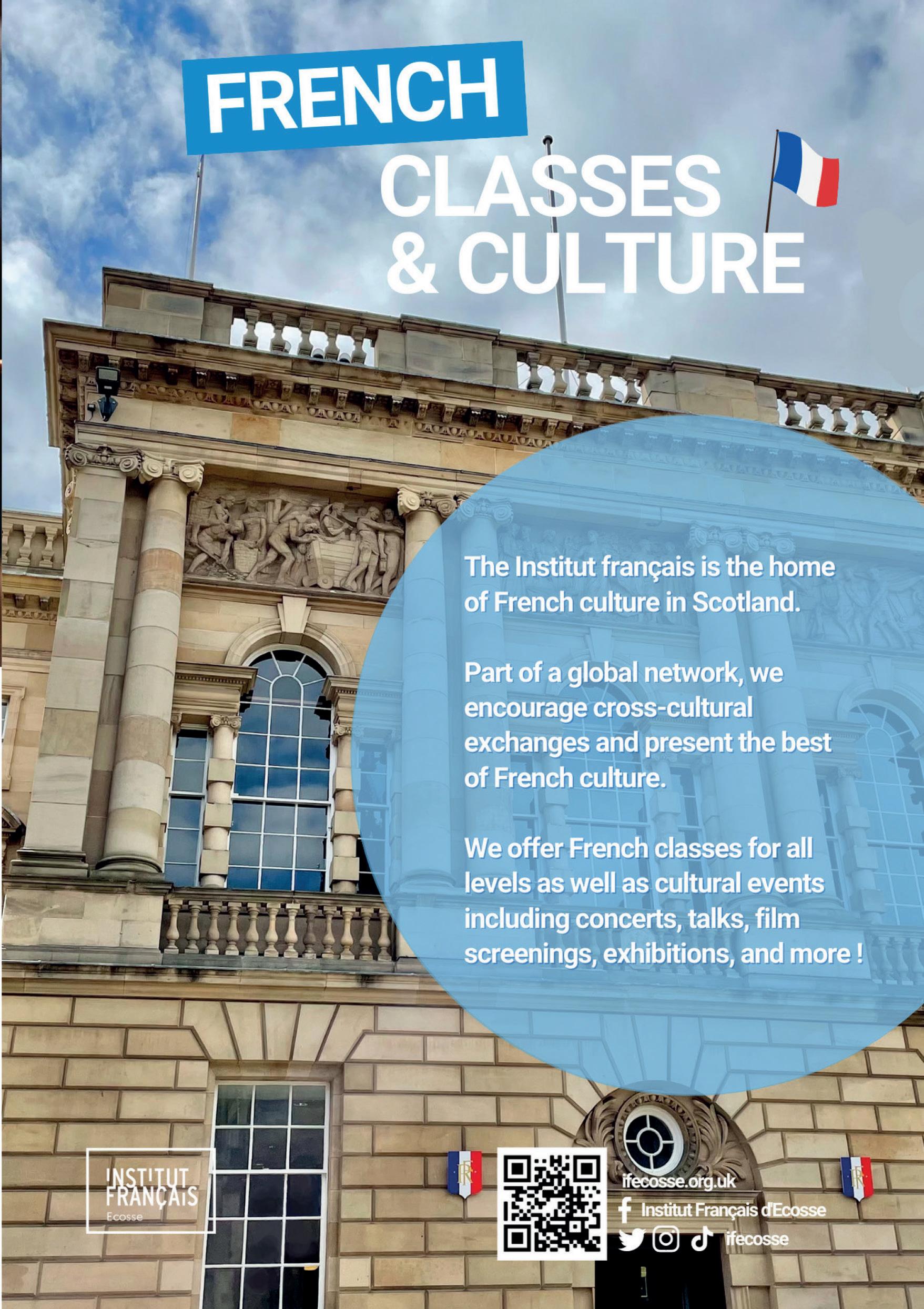

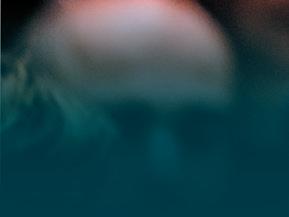
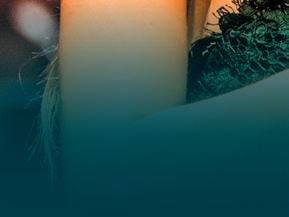

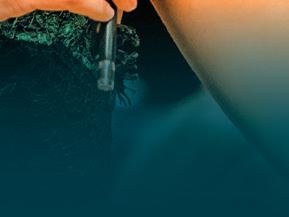

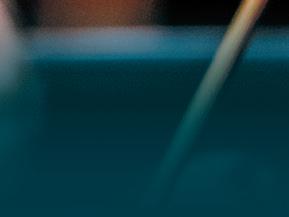






Quilter Cheviot is a proud supporter of the Benedetti Series 2023, in partnership with the Scottish Chamber Orchestra. The extension of our partnership continues to show our commitment in supporting culture and the arts in the communities we operate.
For over 250 years, we have been performing for our clients, building and preserving their wealth. Our Discretionary Portfolio Service comes with a dedicated investment manager and local team who aspire to deliver the highest level of personal service, working with you to achieve your goals.
To find out more about investing with us, please visit www.quiltercheviot.com

For 50 years, the SCO has inspired audiences across Scotland and beyond.
From world-class music-making to pioneering creative learning and community work, we are passionate about transforming lives through the power of music and we could not do it without regular donations from our valued supporters.
If you are passionate about music, and want to contribute to the SCO’s continued success, please consider making a monthly or annual donation today. Each and every contribution is crucial, and your support is truly appreciated.
For more information on how you can become a regular donor, please get in touch with Hannah Wilkinson on 0131 478 8364 or hannah.wilkinson@sco.org.uk
sco.org.uk/support-us